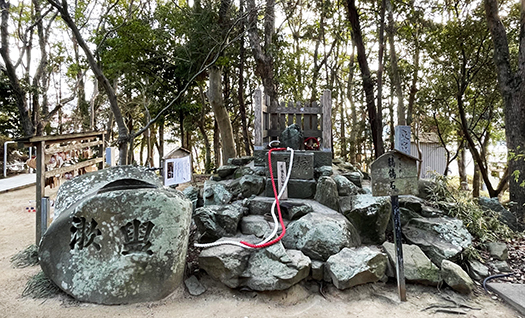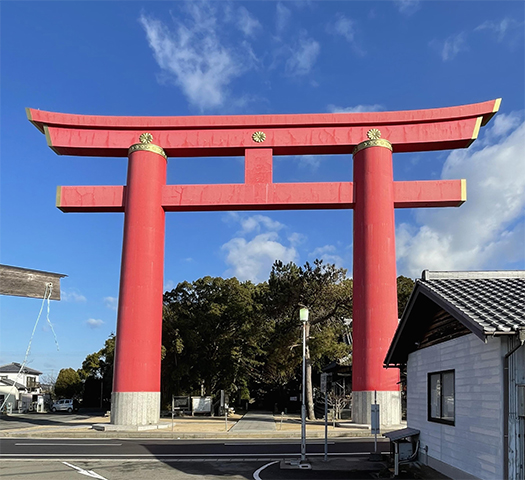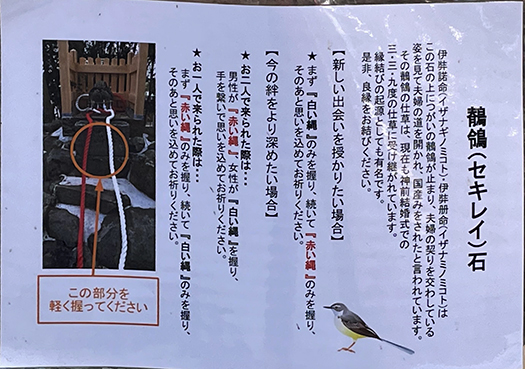


住宅のことをライフワークにしたことで、自然に「この国に住む」という当たり前の現実に突き当たるようになる。住むということは必然的に「定住」することであり、その場所・空間について考えることが必然。当然気候風土のような自然条件を探究し、それへの対応の最適解を考えることになる。至極当然。
そうなると人為のことも当然、自然条件と並んで文化的側面として考えることになる。「これこれこういう自然条件に対応した住宅空間を考える人間は、さてどういう生活信条を持っているのか?」というポイント。
住宅を取材すれば「神棚」はかなりの割合でみなさん、配置されている。日本列島に暮らす人間として素朴な信条として神社信仰は深く根付いている。先般、その神社信仰のひとつのルーツとも思える兵庫県南あわじ市にある「おのころ神社」を探訪。以前放映された「ブラタモリ」での情報なども重ね合わせながら体験しておりました。
おのころ、あるいはおのごろと言われる地は、イザナギ・イザナミの夫婦神による「国産み」神話では一番最初に生み出された島として名前が出てくる。そこから淡路島が最初にできて、やがて大八洲列島が形成されていったという伝承。ちょうど夫婦旅のこの正月最後の訪問地としてふさわしい。
神社境内には「鶺鴒〜セキレイ石」が置かれている。2神はこの岩の上で羽を休めていた夫婦のセキレイが契りを交わしているのを見て国産みをされたという伝承。このセキレイの姿が、神前結婚式での三三九度の仕草の原型なのだという解説が書かれている・・・。まったく知らなかった(笑)。
で、紅白の綱が鶺鴒石に懸けられていて、男女ペアが、あるいは出会いを求める単身者が作法に則って、願いをかける。なかなか納得感のある信仰装置だと思わされる。
日本の神話は世界でも非常に独特な神話であり、またロマンチックでもあると思いますが、こういう人生の決定場面でもこんなマンガチックな行為規範がひもとかれる。たしかにセキレイたちの仕草として首の上下動は特徴的。そういう自然への観察がルーツの説話の中に仕掛けられている想像力はすばらしい。神であるイザナギ・イザナミも自然の摂理に対して素直であり従順であるということが日本的心性のなにかと繋がっているように思える。
東アジア世界の中で独立国家社会として外交を開始していくときに、こういう自国文化について深く検証も進んでいったのだろうと思われる。その後も西洋文明とも出会っていくけれど、原初に於いてこういう自然との調和概念があることで、受容することに大きなこだわりがなかったのだろう。セキレイに学ぶ心性は素晴らしい。
English version⬇
Onokoro-jima” Shrine of the Myth of the Birth of the Nation -1
The myth of the birth of the nation in the Japanese archipelago describes a Sekirei, and the two deities Izanagi and Izanami followed its example. This is said to be the original form of the 339th degree. Oh. …
Having made housing his life’s work, he naturally comes up against the obvious reality of “living in this country. To live in this country inevitably means to “settle down,” and it is inevitable to think about the place and space in which one lives. Naturally, we must explore natural conditions such as climate and climate change, and consider the best solution to cope with them. It is quite natural.
This naturally leads to the consideration of human activities as a cultural aspect as well as natural conditions. The question is, “What kind of life philosophy does a person who thinks of a residential space that responds to such and such natural conditions have? This is the point.
If you visit a house, you will find that a large percentage of them have a “kamidana” (Shinto altar) in the house. As people living in the Japanese archipelago, the belief in shrines is deeply rooted in our simple beliefs. Recently, I visited Onokoro Shrine in Minami-Awaji City, Hyogo Prefecture, which seems to be one of the roots of this shrine belief. I had experienced the shrine while overlaying information from a previously broadcast “Bratamori” on my visit.
The place called Onokoro or Onogoro is named as the first island created in the myth of “Kuninosumi” by Izanagi and Izanami, a couple of gods. The tradition says that Awaji Island was first created from there, and eventually the Oyasu Islands were formed. It is a fitting place for the last stop on this New Year’s Day trip for a married couple.
The legend explains that the wagtails’ appearance is the prototype of the sansan-kudo gesture used in Shinto weddings. I had no idea (laughs).
A red and white rope is hung on the Minoekagari stone, and a male-female pair, or a single person seeking to meet someone, makes a wish according to the ritual. It is quite a convincing religious device.
Japanese mythology is one of the most unique and romantic myths in the world, but even in this kind of life-determining situation, such a cartoonish code of conduct can be found. It is true that the up-and-down movement of the neck is a characteristic gesture of wagtails. It is wonderful that such observation of nature is imaginatively incorporated into the mythology of the roots of the story. The fact that the gods Izanagi and Izanami are also obedient and obedient to the laws of nature seems to be connected to something in the Japanese psyche.
As Japan began its diplomatic activities as an independent nation-state in East Asia, it is likely that it began to examine its own culture in depth. Although they encountered Western civilization later on, they were not so particular about accepting it because they had this concept of harmony with nature in their primitive age. It is wonderful to learn from the Sekirei.
Posted on 4月 29th, 2023 by 三木 奎吾
Filed under: こちら発行人です







コメントを投稿
「※誹謗中傷や、悪意のある書き込み、営利目的などのコメントを防ぐために、投稿された全てのコメントは一時的に保留されますのでご了承ください。」
You must be logged in to post a comment.